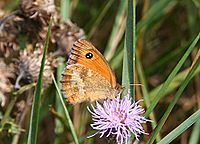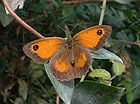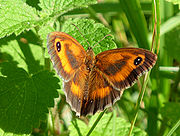
Gatekeeper Butterfly
Encyclopedia
The Gatekeeper sometimes called the Hedge Brown is a common butterfly in the United Kingdom
. It is a member of the subfamily Satyrinae
in the family Nymphalidae
. A similar species is the Meadow Brown
; the two species can be difficult to distinguish with closed wings since underwing markings are very similar. However, the Gatekeeper tends to rest with its wings open, whereas the Meadow Brown usually rests with its wings closed. The Gatekeeper is also smaller and more orange than the Meadow Brown and has double pupils on its eyespots.
of meadow margins and hedges; field gates are often in such locations, and thus the Gatekeeper can be found much more frequently in such locations than the Meadow Brown for example.
 The larva
The larva
e of Satyrinae all feed on grasses, such as Rough Meadowgrass Poa trivialis
, Smooth Meadow Grass Poa pratensis, Sheep's Fescue
, and are usually green or brown in colour. The pupae are a flimsy chrysalis either hanging upside down or lying in grass. The adults are often found round blackberry
plants. The adult butterflies have a quite short proboscis and the flowers of the blackberry being quite shallow provide an excellent nectar source. Males have a dark patch of scent scales
in the middle of the forewing for courtship purposes except in very old individuals. This dark patch is clearly visible in the male Gatekeeper. The characteristic eyespot
s on the forewing probably deflect bird
attacks away from the butterfly's body rather than startle away predators; the Gatekeeper likes to rest with its wings open and the eyespots visible. It flies more but strays about less than the male Meadow Brown.
Two similar species of Pyronia are found in southern Europe, the Southern Gatekeeper (P. cecilia
) and the Spanish Gatekeeper (P. bathsheba
).
, exhibit sexual dimorphism
. The male has a dark patch on the upper side of the forewing. This is an area of scent-producing scales known as the androconia.
United Kingdom
The United Kingdom of Great Britain and Northern IrelandIn the United Kingdom and Dependencies, other languages have been officially recognised as legitimate autochthonous languages under the European Charter for Regional or Minority Languages...
. It is a member of the subfamily Satyrinae
Satyrinae
Satyrinae, the satyrines or satyrids, commonly known as the Browns, is a subfamily of the Nymphalidae . They were formerly considered a distinct family, Satyridae. This group contains nearly half of the known diversity of brush-footed butterflies...
in the family Nymphalidae
Nymphalidae
The Nymphalidae is a family of about 5,000 species of butterflies which are distributed throughout most of the world. These are usually medium sized to large butterflies. Most species have a reduced pair of forelegs and many hold their colourful wings flat when resting. They are also called...
. A similar species is the Meadow Brown
Meadow Brown
The Meadow Brown, Maniola jurtina, is a butterfly found in European meadows, where its larvae feed on grasses, such as Sheep's Fescue.Similar species are Gatekeeper and Small Heath ....
; the two species can be difficult to distinguish with closed wings since underwing markings are very similar. However, the Gatekeeper tends to rest with its wings open, whereas the Meadow Brown usually rests with its wings closed. The Gatekeeper is also smaller and more orange than the Meadow Brown and has double pupils on its eyespots.
Etymology
The name "Gatekeeper" may refer to its frequent occurrence near field gates and to the man who was responsible for the toll gates in the eighteenth and nineteenth centuries when butterflies were more numerous than they are today. As indicated by its alternate name, the gatekeeper butterfly prefers the habitatHabitat
* Habitat , a place where a species lives and grows*Human habitat, a place where humans live, work or play** Space habitat, a space station intended as a permanent settlement...
of meadow margins and hedges; field gates are often in such locations, and thus the Gatekeeper can be found much more frequently in such locations than the Meadow Brown for example.
Biology

Larva
A larva is a distinct juvenile form many animals undergo before metamorphosis into adults. Animals with indirect development such as insects, amphibians, or cnidarians typically have a larval phase of their life cycle...
e of Satyrinae all feed on grasses, such as Rough Meadowgrass Poa trivialis
Poa trivialis
Poa trivialis , is a perennial plant, and is regarded in the USA as an ornamental plant and is of the Poa family.-Description:...
, Smooth Meadow Grass Poa pratensis, Sheep's Fescue
Sheep's Fescue
Sheep's Fescue or Sheep Fescue is a species of grass.-General Description:It is a perennial plant sometimes found in acidic ground, for example in the Portlethen Moss, Scotland and mountain pasture, throughout Europe and eastwards across much of Asia; it has also been introduced to North...
, and are usually green or brown in colour. The pupae are a flimsy chrysalis either hanging upside down or lying in grass. The adults are often found round blackberry
Blackberry
The blackberry is an edible fruit produced by any of several species in the Rubus genus of the Rosaceae family. The fruit is not a true berry; botanically it is termed an aggregate fruit, composed of small drupelets. The plants typically have biennial canes and perennial roots. Blackberries and...
plants. The adult butterflies have a quite short proboscis and the flowers of the blackberry being quite shallow provide an excellent nectar source. Males have a dark patch of scent scales
Scale (zoology)
In most biological nomenclature, a scale is a small rigid plate that grows out of an animal's skin to provide protection. In lepidopteran species, scales are plates on the surface of the insect wing, and provide coloration...
in the middle of the forewing for courtship purposes except in very old individuals. This dark patch is clearly visible in the male Gatekeeper. The characteristic eyespot
Eyespot (mimicry)
An eyespot is an eye-like marking. They are found on butterflies, reptiles, birds and fish. In members of the Felidae family , the white circular markings on the backs of the ears are termed ocelli, and they are functionally similar to eyespots in other animals.Eyespots may be a form of...
s on the forewing probably deflect bird
Bird
Birds are feathered, winged, bipedal, endothermic , egg-laying, vertebrate animals. Around 10,000 living species and 188 families makes them the most speciose class of tetrapod vertebrates. They inhabit ecosystems across the globe, from the Arctic to the Antarctic. Extant birds range in size from...
attacks away from the butterfly's body rather than startle away predators; the Gatekeeper likes to rest with its wings open and the eyespots visible. It flies more but strays about less than the male Meadow Brown.
Two similar species of Pyronia are found in southern Europe, the Southern Gatekeeper (P. cecilia
Pyronia cecilia
The Southern Gatekeeper, Pyronia cecilia, is a butterfly of southern Europe and north Africa. It is a member of the subfamily Satyrinae in the family Nymphalidae.-Description:...
) and the Spanish Gatekeeper (P. bathsheba
Pyronia bathseba
The Spanish Gatekeeper is a butterfly of the Nymphalidae family. It is found on the Iberian Peninsula and in France, Morocco and Algeria.The wingspan is 18–19 mm. The butterfly is on wing from May to July depending on the location....
).
Sexual dimorphism
The Gatekeeper, like many SatyrinaeSatyrinae
Satyrinae, the satyrines or satyrids, commonly known as the Browns, is a subfamily of the Nymphalidae . They were formerly considered a distinct family, Satyridae. This group contains nearly half of the known diversity of brush-footed butterflies...
, exhibit sexual dimorphism
Sexual dimorphism
Sexual dimorphism is a phenotypic difference between males and females of the same species. Examples of such differences include differences in morphology, ornamentation, and behavior.-Examples:-Ornamentation / coloration:...
. The male has a dark patch on the upper side of the forewing. This is an area of scent-producing scales known as the androconia.
 |
 |

